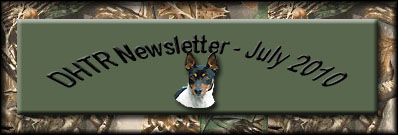I have, in my previous article briefly touched on a few tips and opinions
regarding the training and procurement of a young pup, squirrel dog prospect.
I will attempt to expound, slowly on the subject matter. After one has
“bonded” or at least handled the pup in question with some confidence,
it is exceedingly important to have a good handle on your dog. I know,
puppies can be hardheaded and…yes, like children and men they do “suffer”
from selective hearing but it is imperative to one’s ultimate success (both
in terms of safety and goals) to have control of your canine. I am not
going to “preach” about obedience but in all actuality, the dog and your
own well being may be affected by his/her willingness to heed the human’s
command.
When squirrel training/hunting with terrier puppies, having a firm “handle”
on the dog may not seem like such a big deal, since these terriers generally,
will hunt so close and young dogs are notorious for staying on one’s heels
during their first trips to the woods but it is often during those early
experiences that good and bad habits alike are learned and or reinforced.
There are all sorts of techniques or practices utilized when first taking
a pup out for that first season of hunting; taking the pup out with an
older, solid tree dog, hunting the pup alone, hunting with two pups, etc.
I have done all these and from my experience, I have had the greatest success
by taking a pup out alone. Maybe it is because there are fewer distractions,
better one on one time I suppose, if it all possible I would strongly suggest
taking a young dog (one that has seen less than two squirrel seasons) alone,
as much as possible.
If you intend on making a good squirrel dog your pup has to know what they
are looking for…period. It does not matter if you use hand signals, words,
whistles or whatever, in order to maximize your success, the pup has to
understand what they are in search of , instead of say just strolling through
the woods and jumping up and running any other mammal that will run from
them or quail, for that matter. For example; at an early age, approx. 12
weeks every time I introduce a squirrel tail, caged squirrel etc., I say
the word squirrel and add encouragement, i.e.; get that squirrel, where’s
the squirrel etc., so that when I say squirrel the pup automatically thinks
back to the smell/image of a squirrel and/or starts scanning the woods
or looking up trees, sniffing around and listening intensely, in search
of the desired quarry. Remember lots of praise (and some treats are fine)
to keep a youngster hot for squirrel.
Hopefully, by the time the pup’s first squirrel season has rolled around
the pup has been exposed to gun fire, the woods, water and the quarry.
Now it’s show time, right, sure. Remember your pup is young and just because
he/she is from a line of grand whatever champions or is from a long line
of versatile and consistent hunting dogs this does not mean that those
adorable little tree rats are going to just scamper down and jump right
in your frying pan. You and that pup are going to have some real work (and
FUN) for at least two seasons anyway. Why two seasons? Because these terrier
types will generally need at least two seasons of fair to heavy hunting
to make a finished dog. Some will need more to make a finished dog, while
others catch on quicker, there is no set time, just like physical and mental
maturity in humans is varied and depends on a number of factors; genetics,
environment and stimuli. I will leave you all with what I deem a helpful
tip when training a young dog and that is to have squirrel feeders set
out in several locations, within the area you plan on hunting. What these
feeders do for you and the pup is they (the feeders) maximize your chances
on running into a squirrel (that is if you replenish the food regularly),
and at this point (a pup or young dog) needs all the exposure that they
can get to the squirrel. I generally use corn as squirrel feed; I buy it
100 lb sacks and store it in the garage. Here is a helpful link to a do-it-yourself
feeder. http://www.sqdog.com/Equipment/Feeder/Feeder.html
The key tools in squirrel hunting success lie in breeding, working and
consistency. Breeding, is never a given, even the best bloodlines throw
off duds and even some lines of dogs not known for particular treeing prowess
can throw off an occasional powerhouse. It is the consistent, tree producing
lines or individuals of proven crosses that one has the best chance of
acquiring a dog with the built in “software” needed to be a good squirrel
dog. Working starts practically from day one; from early handling and interaction,
exposure (people/noises/environment/animals, etc), training and hunting,
the dog is much like a young child soaking up information from its’ environment.
Consistency, most simply is that yes means yes and no means no. Know and
enforce the rules/boundaries that you desire your canine to follow and
respect; get down, come here, don’t chase the deer, chase the deer…whatever.
Remember this, if you can take nothing else from this article; that squirrel
hunting is not rocket science and relax, take it slow and enjoy nature
with your pup. GOD bless.
 ...
...
 ...
...